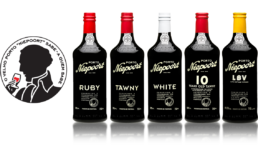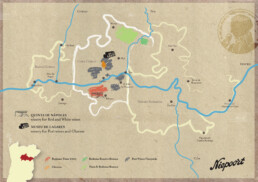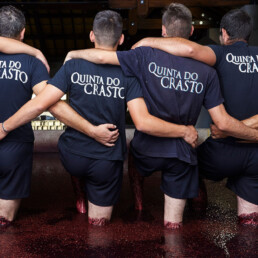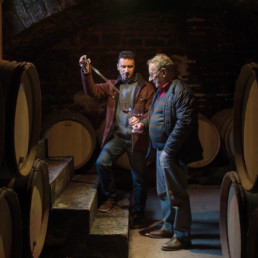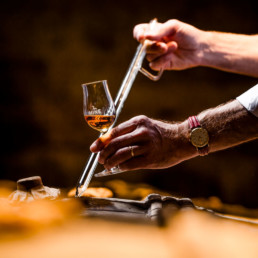… Sure, once upon a time it seemed the reserve of the “pale, male and stale” brigade, only being served in stuffy drawing rooms of a gentleman’s club or after a big boozy long lunch… or perhaps when gran would sneak a sip on the sly before splashing it onto the family fruit cake. But times have definitely changed.
The quality of port being made today is higher than it has ever been, and the range of different styles of port that are reasonably easy to find outside Portugal is so much wider than it was. Indisputably, Vintage Port is truly considered the last great wine bargain on the planet. Top ports, like Niepoort and others, are quality-wise, on par with wines like Latour, Lafite or Grand Cru Burgundy!
Thankfully, Port is making a deserved comeback and Niepoort is the edgy, cool Port House with an innovative 5th generation winemaker raising the bar whilst respecting the deep traditions of this family’s history. We at Dhall & Nash Fine Wines proudly welcome this exciting trendsetter to our stable.
“Niepoort is to Vintage Port what Krug is to Champagne. They are both small houses in a world dominated by large competitors, but they are producing outstanding wines few can match.” – James Suckling, on Vintage Port
The Family Biz
The Niepoort family were Port shippers of Dutch origin that have been making Port in the Douro Valley since 1842. It is a relatively small Port house but with a big reputation! Despite being the second smallest shippers in the trade, they are second to none in quality.
Originally, the company used to buy its grapes from small growers, but since the end of the 80s Niepoort has invested in their own Quintas (vineyards). This is largely thanks to its 5th generation brother and sister team, Dirk and Verena Niepoort. It is easy to forget that it was just a few years ago that Niepoort was only sought out by a small band of faithful followers. These days, with a formidable international reputation which spans all styles from aged tawny to vintage, and all points in between, demand threatens to outstrip supply. Luckily for us in New Zealand, Dhall & Nash has an array of these extraordinary classic ports!
The Niepoort Philosophy
“I like wines with extremes. As rich and tannic as possible, but they have to have harmony.” – Dirk Niepoort (in Wine Anorak)
Indeed, it has always been the Niepoort mission, to be a “niche player”, to produce distinctive Ports and Douro wines, combining centuries-old tradition with innovation. This marriage of old and new continues today where Dirk has striven to improve the company’s Ports and to upgrade their vineyards. The importance attached to understanding soils, microclimates and grape varieties has led Dirk Niepoort down the path of organics and biodynamics, a practise that respects the “moods” of nature, to find a balance between biodiversity and minimum intervention, and the wines really speak for themselves. Many of their vineyards now have organic certification, which is very much against the grain in contemporary Port making but not for the ingenious Dirk and his team.
In the winemaking arena, Dirk is also a passionate advocate of the traditional method of “treading” by foot to extract maximum colour and flavour. Their Ports are all made at the old Museu de Lagares in Vale de Mendiz, which has the last remaining circular granite Lagares (low stone troughs) in the Douro. Embracing these traditional methods as well as the modern has resulted in magnificent highly acclaimed examples from all recently declared vintage years.
19.5/20 Jancis Robinson (for the 2017 Vintage)
98/100 James Suckling (for the 2017 Vintage)
The art of Master Blender has also passed from generation to generation. José Nogueira was the fourth of his family to pursue his art in Niepoort, having worked at the company for over 50 years. His son José Rodrigo joined the team in September 2006 and they worked together until 2011. He is currently the fifth generation of the Nogueira family.
Dirk van der Niepoort ‘The Charismatic’:
Niepoort has acquired an almost legendary reputation since Dirk took over the company – and rightly so. Dirk loves wine – and he produces a myriad of styles of exceptional quality. Not bad for someone who never had any formal training or ever studied oenology. This madly passionate wine geek is a naturally intuitive winemaker and gladly shares his ideas with fellow winemakers and wine lovers alike. Equally as happy to learn as much as he can from international wine aficionados.
“…With an enigmatic expression concealing dry humour, incisive vision and a passion for fine wine verging on the obsessive, he is the uncrowned king of the Cima Corgo.” – Rui Lourenco Pereira, The Wine Spy
Although raised in a port producing family, Dirk came to winemaking late in the piece after studying economics and working in Switzerland. The first wine Dirk participated in making was the Niepoort Vintage Port of 1987. Since being “bitten by the wine bug” he has taken over the firm management and has also started making excellent dry table wines in addition to the wide range of Port styles they are famous for. His approach seems to hinge on respect for the greatness of their terroir, the vines and also having an almost fanatical view of accurately interpreting the Douro expressiveness that is and will be the Niepoort legacy.
“It is Dirk’s passion for wines and his humble respect and curiosity for the Douro terroir that defined Niepoort spirit over the last three decades and is a constant inspiration and challenge for the team.” – Niepoort
Wine & Spirits magazine named Dirk Niepoort as one of 50 “Most Influential Winemakers of 2004”:
“What sets Niepoort apart is his skill at building networks, pathways of communication… Despite his varied projects… Niepoort never seems particularly stressed. His eye is still on his Niepoort wines, which only seem to get better…. Dirk Niepoort has not only transformed his family’s company, he’s helped transform the region and the way the world thinks about wine.”
Niepoort White Port

The White Port is made from white grapes: Malvasia, Viosinho and Gouveio. The juice is fermented as a white wine until the fermentation is stopped by the addition of pure grape brandy. After spending one year in large wood vats the wine is transferred to casks (550 litre oak barrels). It is then aged in wood until at least three years before bottling. Deep gold, with nuts and hints of fruit fresh aromas and a half sweet taste. Serve chilled as an aperitif or with tonic water as a refreshing spritzer!
89 points from Wine Spectator: “Golden / brown in colour with a delightful aroma of nuts and almonds which comes through on the palate with a fresh concentrated spirity finish, from extended ageing in small old oak barrels.”
Niepoort Ruby Port

The Ruby Port ages an average of three years in large wooden casks at Niepoort cellars, in Vila Nova de Gaia. The grapes come from old vineyards in Cima Corgo region of Douro Valley. Niepoort’s Ruby is fresh, young and fruity. An expressive Port with great character. Ruby keeps well for several years, although the wine will not improve with age. No decanting is necessary since the wine contains no sediment.
85 points from Wine Enthusiast: “Ripe, intense, dry fruit-flavoured ruby Port that has depth of fruit and well-integrated spirit. A great, everyday drinking Port.”
Niepoort Tawny Port

To produce a Port wine with a fine and balanced flavour, Niepoort Tawny ages in oak casks for 3.5 years. Freshness, lightness and balance are the key elements of this wine. A Port easy to drink on any occasion. Tawny has a shiny bright colour and soft and sweet tannins. Tawny Port keeps well for several years, although the wine will not improve with age.
88 points from Wine Spectator: “Brick red / tawny in colour, with delicate nutty aromas and a hint of dried fruits. on the palate, very well balanced with a youthful fruity, luscious character, which integrates well with a long spirity finish.”
Niepoort 10 Year Old Tawny Port

Tawnies with an age indication of ’10 years’ are blended from different wines averaging 10 years. The prolonged ageing in small old oak casks (550L) confers the characteristic tawny colour. The main features of an aged Tawny are the complexity of aromas, the freshness and a persistent bouquet and refinement. The balanced marriage of the different characteristics and diverse ages is the art of the Niepoort’s Master Blender, José Nogueira.
91 points from Robert Parker: “Tawny in colour, with aromas of dried apricots and crystallized tangerine peel well integrated with a nutty character. The palate reveals dried fruits with a fiery spirity finish. With a great structure and a long finish. This offers amazing aromas of orange and lemon peel, with hints of toffee, caramel and honey. Fullbodied and luscious, with lots of sweet fruit and a long subtle finish that goes on and on. This is really the benchmark for 10-year-old tawnies.”
Niepoort 2015 Late Bottled Vintage Port

From 70-year-old vines. This wine is aged 4-6 years in old oak casks (opposed to Vintage that ages 2-3). The 2014/2015 vintage experienced a cold and very dry winter, with rainfall at a record low compared to previous years. In addition to this, the spring and summer seasons were dry and hot, with three heat waves in the months of June and July preceding a very cool August. Low humidity levels pushed the risk of fungal disease to a historical low, which allowed the vines to produce outstandingly healthy grapes – an important factor for a great Port. What makes 2015 such an exceptional vintage is the perfect condition of the fruit thanks to the low humidity during the vegetative phase of the vine, resulting in a Port with great freshness, and the pronounced acidity typical of the Niepoort style, as well as a beautiful colour.
Simply said, Niepoort Port is truly a beautiful thing…
These divine, intensely flavoured fortified wines take centre stage whenever they appear – and deservedly so. As Port matures, the firm tannins and intense fruity flavours of youth gradually give way to the velvety smoothness and mellow, nuanced complex characters which develop with age. They are wines to be savoured on their own, or with fine food. Perhaps now is the time to buy some for Christmas or just treat yourselves to a “ruby gleam or a tawny dream”. Enjoy!
Let’s Get to Know Port Better…
Port wine is produced in the mountainous Eastern reaches of the Douro Valley in northern Portugal, one of the world’s oldest and most stunning vineyard areas where wine has been made for at least two thousand years – and Port wine for over 300 years!
Port is a fortified red or white wine made by adding brandy to stop fermentation which results in a wine that is both sweet and high in alcohol. It was originally created as a way to preserve the country’s wines during their long, hot journey down the Douro River to the town of Oporto to then to be shipped onto England.
Ports are often labelled under the name of their shipper – e.g. Graham, Dow or Fonseca – who is responsible for blending, maturing and bottling the wines before exporting.
A Short History
The British have played a crucial role in Port’s history, which continues to this day. Port started life as a full-bodied, dry red wine, known in 17th century London as ‘blackstrap’. Brandy was often added to the wine by British merchants to ensure it arrived in good condition. In 1678, however, two English wine merchants visiting the Douro region found the “sweet-ish and extremely smooth” wines of the Abbot of Lamego, better than any others they had tasted. The Abbot admitted adding brandy to the wine during (rather than after) fermentation, and the two Englishmen bought all of his stock and shipped it home. At the same time several now-famous companies were being established in the region: what was to become Warre set up in 1670, Croft was founded in 1678, and Taylor’s in 1692. The Methuen Treaty of 1703 that gave Portuguese wines preferential duty rates in Britain added a welcome boost, while the measures introduced by the Marquis of Pombal – including the demarcation of the Douro Port region in 1756 and the ban on using elderberry juice – helped improve and ensure quality. The firm foundations for modern day port had thus begun.
“Port evokes a magical place, an historic place” – Niepoort
Terroir
Port comes from the Douro region, about 50 miles east of Oporto, specifically the subregions of the Cima Corgo, Baixo Corgo and Douro Superior. The Cima (Higher) is the heart of the Port-producing region, centred around the town of Pinhão, and is the source of most high quality Ports. Like other great classic wines, Port owes its distinctive character to a unique association of climate, soil, grape variety and wine making tradition. The unique terroir of the Douro Valley is the key for growing the more than 80 red and white wine grapes used to make port. The most common local grapes making their way into bottles of port are Touriga Nacional (which offers consistent structure), Touriga Franca (which adds a softer edge, with velvety tannins), and Tinta Roriz (same delicious grape as Spain’s Tempranillo). These indigenous grapes favour the dry climate and rocky soils of the Douro Valley. The vineyards are principally on inhospitable granite and schist soils, and the temperatures very hot. Mechanisation is tricky to say the least as the vines grow on steeply terraced hillsides.
As the local saying goes “the Douro Valley has two seasons: 4 months of winter and 8 months of hell.” – thanks to the average summer temperatures hovering at 35-40 degrees C!
Port Production
Production starts off similar to other still wines. Once harvested, the grapes are pressed (often still by foot in stone lagares) to extract the juice and initiate fermentation. The grapes ferment for several days until alcohol levels reach around 6-8 percent. The young wine is then fortified with brandy to bring the fermentation process to a sudden stop and to capture the new wine’s youthful fruit nuances. This fortification will leave the residual sugar levels considerably higher than most still wines making it rich, round and smooth on the palate. Frequently, the batch of young port is pumped into large oak casks, typically for 18 months or so of aging (some port is bottle-aged, skipping the barrels). At the year and a half mark, these young port wines are blended with other batches to find complementary components that will ultimately deliver a delicious wine with well-defined fruit, friendly palate appeal, and superb balance. The young port may then be transferred to bottles for further ageing or receive additional time in a cask depending on its style. The maturation process then harmonises the fruit, tannins and alcohol in the wine, which by this time is about 19-20 percent alcohol.
Styles of Port
Undoubtedly one of the most fascinating aspects of Port wine is its variety of different styles, each with its own characteristic flavours, from the intense berry fruit flavours of a Reserve or a Late Bottled Vintage (LBV) to the rich mellowness of an Aged Tawny or the sublime complexity of a Vintage Port. These distinctive styles of Port derive essentially from the various ways in which it can be aged. Its remarkable ageing potential and the fact that it is fortified means that Port will continue to improve in cask, vat or bottle for much longer than most other wines.
There are, broadly speaking, two main distinctions for port wine: Bottle-aged port and Cask-aged port.
Cask-aged Ports are aged in wooden casks until they are perfectly ready to drink. Within the wood aged Port family, there are three main styles:
- Full bodied, fruity red Ports which age for a relatively short time in large oak vats. These include Ruby Ports, usually aged in vat for two or three years, Reserve Ports which are generally of higher quality and age for slightly longer and Late Bottled Vintage (LBV) Ports which remain in vat for between four and six years. Although offering different degrees of complexity and sophistication, these wines share a deep red youthful colour and intense fruity flavours reminiscent of cherry, blackberry and blackcurrant.
- Rich and mellow Tawny Ports which age for longer periods in oak casks. These include the sumptuous 10, 20, 30 and 40 year old Tawny Ports whose delicious nuttiness and aromas of butterscotch and fine oak wood intensify the longer they spend in wood. And Colheita Ports (aka Single Harvest Reserve) aged for a minimum of 7 years in small casks then released.
- White Ports, made from classic white Port grapes, which are usually aged for two or three years in large vats and are available in sweeter or drier styles. White port is experiencing a revival at hip wine bars lately. It used to be a simple wine drunk almost exclusively by the port trade as an aperitif, with or without tonic water. But some port companies are releasing half-bottles of seriously interesting cask-aged white ports. Worth a try this summer!
The bottled-aged family of Ports is made up mainly of Vintage Port although it also includes a small category called Crusted Port and Single Quinta Port:
- Vintage Port represents the very best produce of a single outstanding year. It remains in vat for only about two years and then ages in bottle. Vintage port is truly the pinnacle – powerful yet refined, magical yet worldly; harmoniously perfect. Vintage Port requires so long in bottle that the 1977s are only just coming around now. A new vintage, 2017, has just been “declared”, as they say in the business. This is the tradition that port shippers would not announce their intention to bottle a Vintage Port until the wine has had two winters in cask and, of course, they have had a chance to see whether the subsequent vintage was better quality. Although Vintage Ports can be enjoyed when young, they will improve for many decades in the cellar and are among the most long-lasting of all wines.
- Crusted Ports are not made from wines of a single year but, like Vintage Ports, are capable of maturing in bottle. Also, like VP, they are not filtered before bottling and will form a ‘crust’ (natural sediment) in the bottle as they age. Dirk Niepoort calls this style “the offcuts of Vintage Port”.
- Single Quinta Ports are those Quintas (vineyards) that belong to a particular Port shipper and are made in ‘good’ years but not in outstanding ‘declared’ years. They are aged in wood for 2-3 years and bottled like VP without filtration. Often these wines are held back by shippers and only sold when the wine is considered ready to drink – up to 10 years after harvest.
Interested in trying these Ports for yourself? Get in touch with your account manager or send us an email at info@dnfinewine.com.
